It is always interesting to explore the email spam trends across a large period of time, so this time we’ll compare spam rates within the last 12 months, from October 2011 to October 2012. Here comes the good news: the last month stats revealed an unprecedented drop in the email spam rate.
According to Symantec.Cloud data, the global spam rate dropped by more than 10%, from 75% of email traffic in September, down to 64.8% in October 2012. Please see the chart below to track the email spam trends from October 2011 to October 2012. As you can see, the last month’s spam rate is very similar to the “dead months” in 2011, March and April, when the percentage of spam messages went down to 64.52%.
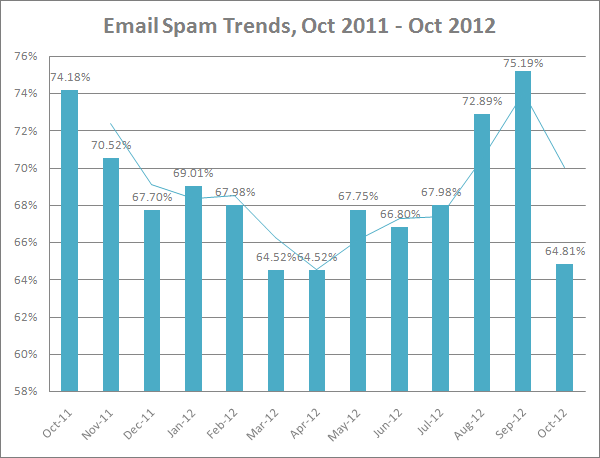
Reasons for the Sudden Drop of the Email Spam Rate in October 2012
As suggested by the editors of the latest Symantec Intelligence Report, one of the reasons for the sudden decline in email spam rates in October 2012 could be the disappearance of the Festi botnet which has apparently been hosted in Saudi Arabia in recent months.
By the way, if we take a closer look at the list of countries reported to be the sources of spam in October 2012, we are sure to notice that Saudi Arabia is no longer in the top ten list:
- India – 11.9%
- Brazil – 7.9%
- United States – 6.6%
- Canada – 5%
- Russian Federation 4.6%
- Vietnam – 4.1%
- Peru – 4%
- South Korea – 3.3%
- Romania – 3%
- Turkey – 2.9%
Unfortunately, drops like this one have been noticed before, but other botnets soon replaced the discontinued one, or a “dead” botnet was reincarnated. We’ll see how it goes within the following months,and we can truly hope that the decline will become a steady trend.
Global Spam Categories in October 2012
As we can see from the chart below, the Sex/Dating topic continued to be a leader in October 2012 and accounted for 62.73% of all spam messages. Jobs, Pharma and Watches stayed in the top 4 categories as well and only shifted places between each other: the Jobs topic was especially “popular” last month and accounted for 10.45% of all spam messages.
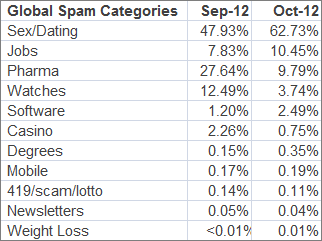
Although email spam rates have recently shown a sudden decline, these rates cannot be compared to the small figures like 8% or 9% typical to the years 2001-2002. You can actually read our blog post on Email Spam Trends across 2001-2012 and feel nostalgic about the olden times…
So email spam is still a big problem both for companies and individuals. That means you still need a good time-proven solution to have a clean and organized Inbox. A good way to go is with EmailTray – an extremely smart email client that sorts all incoming emails and groups them under the Top Priority, Low Priority, No Priority and Spam tabs. EmailTray comes as a Windows email client and an Android email app, both of which are available for free. Get yours now and enjoy a more spam-free mailing experience.

In the previous post dedicated to the email spam statistics for August 2012, we have highlighted the 7 most important tips to stop junk mail. This list of spam prevention techniques definitely has to be extended and requires a dedicated blog post, so here we go!
Be careful with the email addresses that you use
1. Do not use your primary email addresses when registering online. If you don’t want to have your corporate or private email address jammed with spam – do not use them when registering for online promotions, contests, giveaways, download sites, etc.
2. Use a “disposable” email address for online registrations and one-time downloads. You can always create a new email account using free email providers like Gmail, Yahoo!, or Hotmail. You don’t even need to waste time checking this email account for new messages, since you only provide the address to websites and forums as a log-in, and not to your friends or work contacts. If you are your own IT administrator, you can ask your email provider for a catchall service and then, when you signup anywhere, you can describe where you’re signing up before the @ sign with your domain name following (example: forumname@yourdomain.com). With this method, you can just block all emails to that email address if you start getting spam for it.
3. Do not post your email address in public profiles visible by everyone. Keep from posting your email address on forums, blogs and public profiles. To automate the process, spammers use automatic programs to harvest emails, so you provide them with easy food when posting your email here and there.
If you really need to post your address, disguise it from the robots. You can choose to substitute some characters and separate them by brackets – so that your email address no longer looks like one. For example, if your email is “jack.rabbit@example.com”, write it out as “jack.rabbit [at] example [dot] com”.
4. Make your email address hard to guess. Some spam-sending programs coin email addresses using a combination of the randomly-used names and last names, and then send spam to the list of the newly created email addresses. If you don’t want to be included in such a list by accident, make sure to create an email address that is unique.
5. Be very attentive when filling out online forms. See if there are any boxes like “Send a catalogue”, “Receive monthly updates” or “Get free offers” which will often be checked by default. These check boxes are usually small or hidden. Also, read the privacy policy of the services you sign up for; you might unknowingly consent to spam being sent to you.
Remember the three NO’s: no opening, no clicking and no responding
6. Keep away from opening spam messages. When you open an email with graphics rendering turned on, the sender might receive an email delivery receipt which lets them know that your email address is valid. If you were using EmailTray, described below, spam messages would appear in the lower priority Inboxes where graphics rendering is automatically shut off.
7. Do not follow the links in a spam email. Such links might include malware which might result in identity theft. Even if you believe an email is legit, hover over the link with your cursor first to verify that the URL you’re being sent to is also legit.
(more…)
According to Symantec.Cloud data updated on a monthly basis, March and April 2012 were the lowest months for spam attacks within the last 12 months. As we can see from the chart below, May 2012 showed a rising trend and email spam reached a whopping 72.89% rate in August 2012. It is interesting that the spam rate in August 2011 was almost the same: 75.9%.
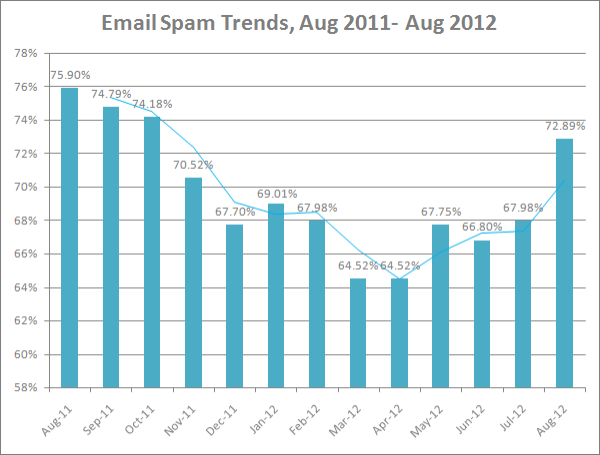
Most Spammed Countries in August 2012
As stated in the Symantec Intelligence Report issued in August 2012, the highest volume of spam was detected in the electronic mail of Saudi Arabian users: 83.3% of all their mail was spam. Norway comes next in the list, with the rate of 78.1%. Chinese users received 77.6% of spam messages; Oman email users experienced a 77.3% spam rate and Brazil users – a 76.7% spam rate.
If we compare these figures to the Symantec’s email spam statistics dated August 2011, we’ll see the following:
Saudi Arabia – 84.8%
China – 81.6%
Italy – 81.3%
Russian Federation – 81.1%
Sweden – 78.8%.
As we see, email users from Saudi Arabia and China suffer from spam more often than the rest of the world.
Global Spam Categories in August 2012
In August 2012, the most common category of spam was related to Sex or Dating, with a 42.51% share among all spam messages. Pharmacy-related messages took second place in the list – with the 32.61% share. The Watches category evened out the top-three list of the most popular spam categories, with a 8.55% share. View the chart below to see how the other spam categories are represented in the list:
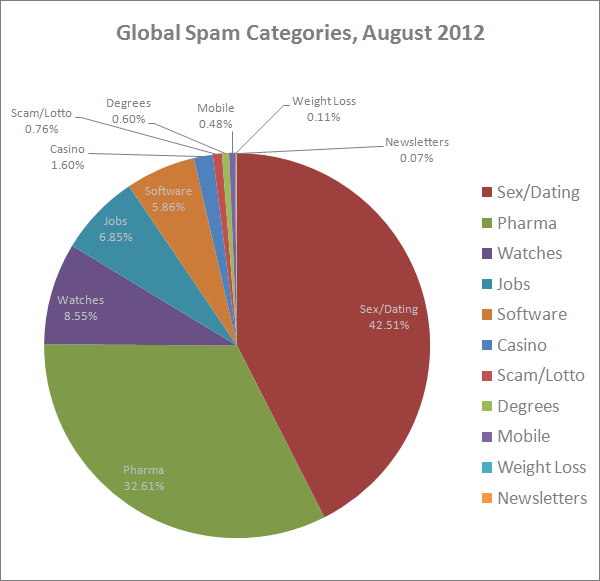
If we compare a Symantec’s Intelligence report issued in August 2012 to the same report issued in August 2011, we’ll see that the top three spam categories haven’t changed (Sex/Dating, Pharmaceutical and Watches), however Jobs and Software-related spam popped up this year:
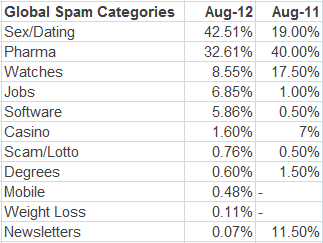
How to Stop Email Spam
This topic deserves a standalone blog post, so we’ll highlight the most important points only:
- Do not give away your primary email address when registering online. Use a secondary or special address for registrations.
- Unless you are a salesperson, don’t include your email address in the public profiles visible by everyone.
- Choose an email address which is difficult to guess.
- Never respond to spam emails such as by asking to unsubscribe – this will confirm your email address validity rather than unsubscribe you.
- Use a spam filter on your computer or in your corporate network.
- Use the “Report spam” option within your email client so that you never receive emails from this sender again.
- Update your anti-viral software on a regular basis.
We never stop saying that you should also try EmailTray – not only because this is our offspring project, but also because it is a really smart email client offering powerful email prioritizing features. With EmailTray, you will be focused on good mail rather than junk mail, so go ahead and download EmailTray for Windows, or grab your smart email app for Android at GooglePlay!
Happy emailing!
Email spam and phishing are serious obstacles on the road to efficient workflow and email productivity. Spam messages clutter your Inbox, distract your attention and absorb your work time while you revise and delete them. Spam emails may contain malware or links to malicious websites, thus putting your computer at risk. Moreover, a large amount of daily spam can make you feel stressed and totally exhausted.
Spam can be deemed less harmful if compared to the fall-outs of phishing. Phishing emails may jeopardize your virtual identity and your financial estate – if you don’t use anti-phishing tools, forget about security and don’t follow the advice on how to avoid scams.
Can you imagine that about 68% of all emails that people receive daily are nothing else than spam? That is a big statistic, especially if you take into account the time that you normally spend on managing your Inbox and sorting emails. The good news is that the spam rate has been decreasing over the last 3 years, and hopefully it will keep on decreasing along with the shutdowns of spam-spreading botnets. The other good news is that you can use intelligent email software to prevent spam and manage your Inbox effectively. Try out the EmailTray email client for Windows or the EmailTray app for Android and see the difference in email productivity before and after using these email programs.
According to a Symantec Intelligence Report issued in February 2012, one of the most spam-affected countries was China. As of February 2012, nearly 74% of all mail received by Chinese users was spam. The Netherlands and the US crowned the list as well by showing the rates of 70% and 68.9% of spam of all incoming mail respectively.
The most popular spam categories are dating, pharmaceutical, jewelry and weight loss; adult-related messages are found in nearly 43% of all spam.
Email phishing is harder to do yet the fall-outs are much more dramatic. Unfortunately one of 298 emails that we receive daily is phishing. Each phishing attack puts your identity at risk and compromises the brand being phished, since the phishing victims constantly lose trust in the brands and service providers which have suffered from the phishing.
See the infographic below to get a bigger picture of spam and phishing trends in 2011 – the beginning of 2012. Click to view the full-size image:

Feel free to post this infographic on your blog using the code below:
<a href="https://www.emailtray.com/blog/email-spam-phishing-trends-2011-2012"><img title="Infographic on Email Spam and Phishing Trends: 2011-2012" src="https://www.emailtray.com/blog/wp-content/uploads/2012/06/email-spam-phishing-trends-2011-2012-infographic-600.png" alt="Email Spam and Phishing Trends: 2011-2012" width="600" height="5590" /></a>
<a href="http://emailtray.com">EmailTray – a Smart Email Client</a>
In a matter of just the past 10 years, email spam has become a multimillion industry. Despite a significant drop in email spam in 2011 (dropping to an average of 75.1% of all email in 2011 compared with 89.1% in the year of 2010), spam continues to be a serious problem for many companies and individual email users.
Email Spam Rate: Fluctuations Over Time
According to a Symantec Intelligence Report issued in February 2012, global spam levels continued to fall, as it now accounts for 68% of global email traffic. If we compare these figures to the data from the previous years’ reports, we’ll see that the email spam rate has been continuously decreasing within the last three years:
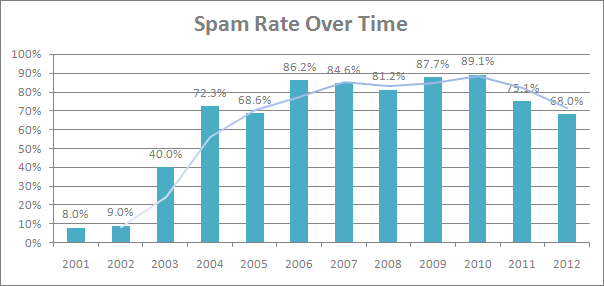
Back in 2001, about 8% of all mail was identified as spam. In 2002 this figure was 9% or 1 in 11.During 2003, MessageLabs Anti-Spam service identified 40% of emails scanned as spam.
The overall spam trend for the first half of 2005 saw a leveling of spam in line with the 2004 yearly figure of 72.3%, with an annual average percentage of 68.6% emails being identified as spam.
One of the key developments in 2006 was a significant increase in spam activity, with levels reaching 86.2%, the highest experienced since 2001.
2007 was the year when botnets came of age. The overall spam trend for 2007 was around 84.6%. Total spam levels averaged 81.2% for the year 2008.
But in 2009 the annual average spam rate was 87.7%, an increase of 6.5 percent on the 2008 statistic. In 2010, the average global spam rate for the year was 89.1%, an increase of 1.4% compared with 2009.
In 2011 the spam rate dropped to an average of 75.1% of all email. The dramatic decline, beginning December 25, 2010 and continuing through January 1, 2011, was the result of both a halt in the spam-sending activities of three botnets – Rustock, Lethic and Xarvester – as well as unrest among pharmaceutical spam-sending gangs.
In the current year of 2012, spam levels have continued to decrease, reaching 68% of all mail in February 2012. Of course things might change by the end of the year and show a totally different picture. However we’ve been observing a descending trend within the last three years so far.
Most Spammed Countries
In February 2012, the highest volume of spam was detected in the electronic mail of Chinese users: 74.7% of all mail. Residents of The Netherlands found a 70% rate of spam messages among their mail. In the US, 68.9% of email was spam; South Africa accounted for 68.8% of spam. UK email users faced 68.6% of spam. Canada and Australia reported slightly lower figures: 68.5% and 68.3% respectively. 67.9% of spam was reported by Hong Kong users as well as users from Germany; Japanese users experienced 65.1% of spam in their mail.
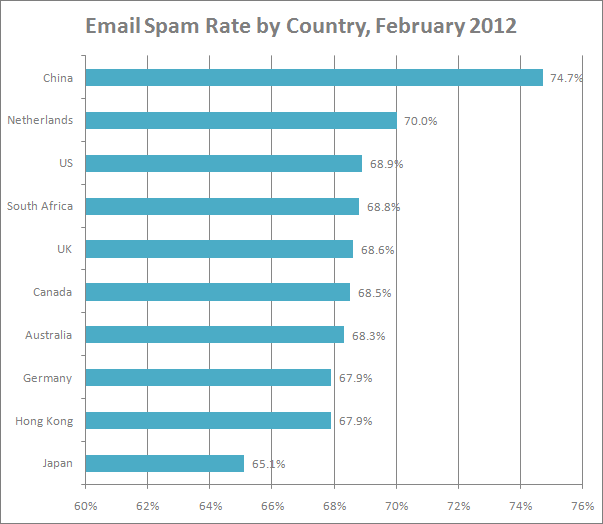
Top Spam Categories
According to a Symantec Intelligence Report issued in February 2012, the most common category of spam was related to the Adult/Dating category, overtaking pharmaceutical related spam for the first time:
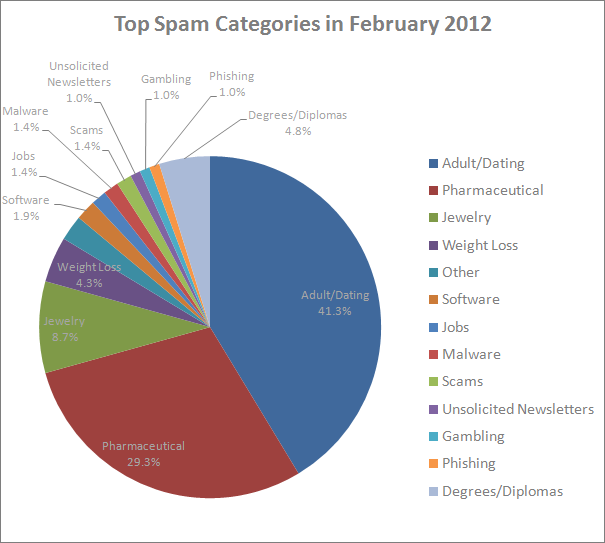
There were particular grounds accounting for the shift in email spam categories. Between 2010 and 2011, pharmaceutical spam fell by 34%, in large part owing to the demise of the Rustock botnet, which was mainly used to pump-out pharmaceutical spam. In contrast, messages about watches and jewelry, as well as sex and dating, both increased as a percentage.










